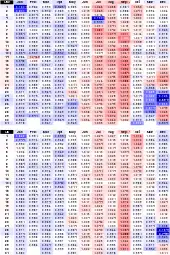Influence of seasonal birth in humans
Seasonal variation in human birth rate has been found to be a nearly universal phenomenon.[1] Also, birth seasonality has been found to be correlated with certain physiological and psychological traits of humans and animals . Evidence for seasonality in humans is limited.[2]

[Legend and sources]
Description

Findings
Influence on medical conditions
The season in which babies are born can have a dramatic effect on their future risk relating to the development of conditions such as neurological disorders, including seasonal affective disorder, bipolar depression, schizophrenia[4][5] and type I diabetes.[6] Research has shown that the season a baby is born in can have a major effect on whether or not they will become a heavy smoker. This even varies between men to women.[7]
Large-scale population analytic studies
Recently, large-scale population analytics have allowed for the exploration of birth month/season hypotheses among large cohorts of people. One study used 1.7 million patients from Columbia University in New York City (NYC) to confirm associations between neurological conditions, respiratory condition and reproductive conditions with birth month.[8] In addition, they uncovered an association between cardiovascular diseases and birth month.[9] This was subsequently confirmed in a separate study, also using data from NYC.[10] Researchers also explored mechanisms correlated with birth season in a large population study including data from 10.5 million patients, from three countries (US, South Korea, and Taiwan) and six study sites.[11] They found correlations between relative age and school cutoff periods. And that first trimester exposure to fine air particulates increased the risk of atrial fibrillation later in life.[12]
As a factor in infant growth
The season during which a birth takes place has been linked to the weight development of the infant as well as initial weight.
As a factor in academic development
There is evidence that suggests that children who are born earlier while they attend the same academic year with others, gain an advantage:
- "In Britain the academic year begins in September, and there may be almost a year's chronological age difference between the eldest (September birthday) and youngest (August birthday) children in the same class. There is evidence that, in this context, children born in the autumn term (September to December birthdays) perform better academically, relative to their class peers, than those born in the spring term (January to April birthdays), who in turn outperform those born in the summer term (May to August birthdays)."[13]
As a suicide risk factor
Birth rates of people who later complete a suicide show disproportionate excess for April, May and June compared with the other months. Overall, the risk of suicide increases by 17% for people born in the spring–early summer compared with those born in the autumn–early winter; this risk increase was larger for women (29.6%) than for men (13.7%).[14]
Research works in Sweden show that those who preferred suicide by hanging rather than poisoning or petrol gases were significantly more likely to be born during February–April. Maximum of the month-of-birth curve for preferring hanging was for March–April and the minimum was for September–October.[15]
References
- "Human Birth Seasonality" (PDF).
- Meyer C, Muto V, Jaspar M, Kussé C, Lambot E, Chellappa SL, Degueldre C, Balteau E, Luxen A, Middleton B, Archer SN, Collette F, Dijk DJ, Phillips C, Maquet P, Vandewalle G. Seasonality in human cognitive brain responses. Proc Natl Acad Sci U S A. 2016 Mar 15;113(11):3066-71. doi: 10.1073/pnas.1518129113. Epub 2016 Feb 8. PMID: 26858432; PMCID: PMC4801294.
- Chandra A (19 December 2006). "How Common Is Your Birthday?". The New York Times.
- Disanto G, Morahan JM, Lacey MV, DeLuca GC, Giovannoni G, Ebers GC, Ramagopalan SV (2012-04-04). "Seasonal distribution of psychiatric births in England". PLOS ONE. 7 (4): e34866. Bibcode:2012PLoSO...734866D. doi:10.1371/journal.pone.0034866. PMC 3319623. PMID 22496872.
- Choi CQ (2012-05-11). "Being Born in Winter Can Mess With Your Head". livescience.com. Retrieved 2021-11-16.
- Watson PE, McDonald BW (November 2007). "Seasonal variation of nutrient intake in pregnancy: effects on infant measures and possible influence on diseases related to season of birth". European Journal of Clinical Nutrition. 61 (11): 1271–80. doi:10.1038/sj.ejcn.1602644. PMID 17299488. S2CID 25462412.
- Riala K, Hakko H, Taanila A, Räsänen P (December 2009). "Season of birth and smoking: findings from the Northern Finland 1966 Birth Cohort". Chronobiology International. 26 (8): 1660–1672. doi:10.3109/07420520903534484. PMID 20030548. S2CID 2486064.
- Boland MR, Shahn Z, Madigan D, Hripcsak G, Tatonetti NP (September 2015). "Birth month affects lifetime disease risk: a phenome-wide method". Journal of the American Medical Informatics Association. 22 (5): 1042–1053. doi:10.1093/jamia/ocv046. PMC 4986668. PMID 26041386.
- Boland MR, Shahn Z, Madigan D, Hripcsak G, Tatonetti NP (September 2015). "Birth month affects lifetime disease risk: a phenome-wide method". Journal of the American Medical Informatics Association. 22 (5): 1042–1053. doi:10.1093/jamia/ocv046. PMC 4986668. PMID 26041386.
- Li L, Boland MR, Miotto R, Tatonetti NP, Dudley JT (September 2016). "Replicating Cardiovascular Condition-Birth Month Associations". Scientific Reports. 6: 33166. Bibcode:2016NatSR...633166L. doi:10.1038/srep33166. PMC 5021975. PMID 27624541.
- Boland MR, Parhi P, Li L, Miotto R, Carroll R, Iqbal U, et al. (March 2018). "Uncovering exposures responsible for birth season - disease effects: a global study". Journal of the American Medical Informatics Association. 25 (3): 275–288. doi:10.1093/jamia/ocx105. PMC 7282503. PMID 29036387.
- Boland MR, Parhi P, Li L, Miotto R, Carroll R, Iqbal U, et al. (March 2018). "Uncovering exposures responsible for birth season - disease effects: a global study". Journal of the American Medical Informatics Association. 25 (3): 275–288. doi:10.1093/jamia/ocx105. PMC 7282503. PMID 29036387.
- Russell RJ, Startup MJ (January 1986). "Month of birth and academic achievement". Personality and Individual Differences. 7 (6): 839–46. doi:10.1016/0191-8869(86)90082-6.
- Salib E, Cortina-Borja M (May 2006). "Effect of month of birth on the risk of suicide". The British Journal of Psychiatry: The Journal of Mental Science. 188 (5): 416–22. doi:10.1192/bjp.bp.105.009118. PMID 16648527. S2CID 13558795.
- Chotai J, Salander Renberg E (May 2002). "Season of birth variations in suicide methods in relation to any history of psychiatric contacts support an independent suicidality trait". Journal of Affective Disorders. 69 (1–3): 69–81. doi:10.1016/s0165-0327(00)00379-7. PMID 12103454.